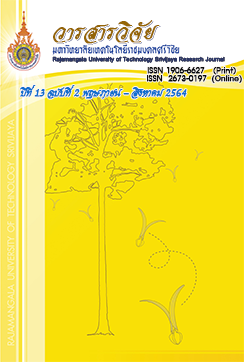สมบัติเชิงกลของพอลิเมอร์ผสมระหว่างเทอร์โมพลาสติกสตาร์ช กับพอลิแลกติกแอซิดที่เติมเถ้าเปลือกทุเรียน
คำสำคัญ:
พอลิแลคติกแอซิด, เทอร์โมพลาสติกสตาร์ช, เถ้าเปลือกทุเรียน, สมบัติเชิงกลบทคัดย่อ
งานวิจัยนี้มีวัตถุประสงค์เพื่อศึกษาสมบัติเชิงกลของเทอร์โมพลาสติกสตาร์ชกับพอลิแลคติกแอซิดที่ผสมด้วยเถ้าเปลือกทุเรียนในปริมาณ 0, 1.25, 2.50, และ 5.00 ร้อยละโดยน้ำหนักของเถ้าเปลือกทุเรียนต่อพอลิเมอร์ผสม โดยนำเถ้าเปลือกทุเรียนไปบดด้วยลูกบอลแบบแพลเนต (Planetary ball mill) ซึ่งขนาดของเถ้าเปลือกทุเรียนลดลงจาก 22.3 ± 2.0 ไมโครเมตร เป็น 9.1 ± 1.0 ไมโครเมตร หลังจากบดเป็นเวลา 1 ชั่วโมง ที่อัตราเร็ว 400 รอบต่อนาที ทำการผสมในเครื่องผสมแบบปิด แล้วนำไปขึ้นรูปด้วยเครื่องอัดขึ้นรูปเพื่อศึกษาสมบัติเชิงกล (การทดสอบค่าความต้านทานแรงดึงและค่าความต้านทานต่อแรงกระแทก) และศึกษาสัณฐานวิทยา จากการทดสอบสมบัติเชิงกล พบว่า ค่าความต้านทานแรงดึงสูงสุดและร้อยละการยืด ณ จุดขาดของชิ้นทดสอบที่เติมเถ้าเปลือกทุเรียนในปริมาณ 1.25 ร้อยละโดยน้ำหนัก มีค่าสูงที่สุด เมื่อเติมเถ้าเปลือกทุเรียนในปริมาณที่สูงขึ้น ค่าความต้านทานแรงดึงสูงสุดและค่าร้อยละการยืด ณ จุดขาดลดลง ค่ายังส์มอดูลัสและค่าความต้านทานต่อแรงกระแทกมีค่าลดลงตามปริมาณที่เพิ่มขึ้นของเถ้าเปลือกทุเรียน การตรวจสอบสัณฐานวิทยาของพอลิเมอร์ผสมกับเถ้าเปลือกทุเรียนด้วยกล้องจุลทรรศน์อิเล็กตรอนแบบส่องกราด (SEM) พบว่าพอลิเมอร์ผสมระหว่างเทอร์โมพลาสติกสตาร์ชกับพอลิแลคติกแอซิดมีการเข้ากันได้ไม่ดีและเถ้าเปลือกทุเรียนมีการกระจายตัวได้ดีในเทอร์โมพลาสติกสตาร์ชมากกว่าพอลิแลคติกแอซิด
เอกสารอ้างอิง
Akramia, M., Ghasemia, I., Azizia H., Karrabia, M. and Mohammad, S. 2016. A new approach in compatibilization of the poly (lactic acid)/thermoplastic starch (PLA/TPS) blends. Carbohydrate Polymers 144: 254-262.
Ferri, J.M., Garcia, G.D., Sánchez, N.L., Fenollar, O. and Balart, R. 2016. The effect of maleinized linseed oil (MLO) on mechical performance of poly (lactic acid) thermoplastic starch (PLA-TPS) blends. Carbohydrate Polymers 147: 60-68.
Hunyek, A. 2019. Mechanical, optical and electrical properties of copper oxide-polypropylene composite. The Journal of King Mongkut's University of Technology North Bangkok 29(3): 527-538. (in Thai)
Kaewtatip, K. 2013. Bioplastics from wheat gluten. KKU Research Journal 41(2): 309-319. (in Thai)
Kunthadong, P., Peekoh, M. and Sindanjark, O. 2019. Biocomposite films based on cassava starch reinforced with durian rind cellulose fibers. RMUTP Research Journal 13(1): 39-50. (in Thai)
Kunthadong, P., Chankaew, C. and Chotichayapong, C. 2020. Soil nutrient rich thermoplastic tapioca starch/water hyacinth bio-composite films. The Journal of King Mongkut's University of Technology North Bangkok 30(1): 104-117. (in Thai)
Pattanasupong, A., Kahapana, C., Sompakdee, N., Srasaengta, N., Tungsatitporn, S. and Bosuwan, K. 2015. Compost quality of poly lactic acid bio-plastic sheet disintegration in a pilot scale test according to ISO 16929:2013. Songklanakarin Journal of Plant Science 2(3): 35-40. (in Thai)
Quyen, T.T.B, Toan, N.V., Nhan, T.C., Thien, D.V.H. and Thanh, L.H.V. 2019. A Simple and rapid preparation of activated carbons with highly surface area from durian shell ash. International Journal of Scientific Engineering and Science 3(4): 65-68.
Rattanapan, A. 2012. Mechanical properties and morphology of PLA filled with nanoclay. The Journal of Industrial Technology 8(3): 69-77. (in Thai)
Suksawat, S. and Pathom-aree W. 2012. The role of bacteria on bioplastic. Srinakharinwirot Science Journal 28(2): 285-304. (in Thai)
Sunduma, T., Szécsényi, K.M. and Kaewtatip, K. 2018. Preparation and characterization of thermoplastic starch composites with fly ash modified by planetary ball milling. Carbohydrate Polymers 191: 198-204.
Sunthontem, S. 2012. Silver nano/poly (lactic acid)/poly (butylene succinate) nanocomposite: preparation, compatibility and properties. Master of Science and Engineering, Silpakorn University. (in Thai)
Tachaphiboonsap, S. 2013. Compatibility and toughness improvement of thermoplastic starch/poly (lactic acid) blends. Master of Engineering, Suranaree University of Technology. (in Thai)
Thammachot, N. 2015. Engineering Materials. SE-Education, Bangkok. (in Thai)
ดาวน์โหลด
เผยแพร่แล้ว
รูปแบบการอ้างอิง
ฉบับ
ประเภทบทความ
สัญญาอนุญาต
ลิขสิทธิ์ (c) 2021 วารสารวิจัย มหาวิทยาลัยเทคโนโลยีราชมงคลศรีวิชัย

อนุญาตภายใต้เงื่อนไข Creative Commons Attribution-NonCommercial-NoDerivatives 4.0 International License.
เนื้อหาและข้อมูลในบทความที่ลงตีพิมพ์ในวารสารวิจัยมหาวิทยาลัยเทคโนโลยีราชมงคลศรีวิชัย ถือเป็นข้อคิดเห็นและความรับผิดชอบของผู้เขียนบทความโดยตรง ซึ่งกองบรรณาธิการวารสารไม่จำเป็น ต้องเห็นด้วย หรือร่วมรับผิดชอบใดๆ
บทความ ข้อมูล เนื้อหา รูปภาพฯลฯ ที่ได้รับการตีพิมพ์ในวารสารวิจัย มหาวิทยาลัยเทคโนโลยีราชมงคลศรีวิชัย ถือเป็นลิขสิทธ์ของวารสารวิจัย มหาวิทยาลัยเทคโนโลยีราชมงคลศรีวิชัย หากบุคคลหรือหน่วยงานใดต้องการนำทั้งหมดหรือส่วนหนึ่งส่วนใดไปเผยแพร่ต่อหรือเพื่อการกระทำการใดๆจะต้องได้รับอนุญาตเป็นลายลักษ์อักษรจากวารสาร มหาวิทยาลัยเทคโนโลยีราชมงคลศรีวิชัยก่อนเท่านั้น







